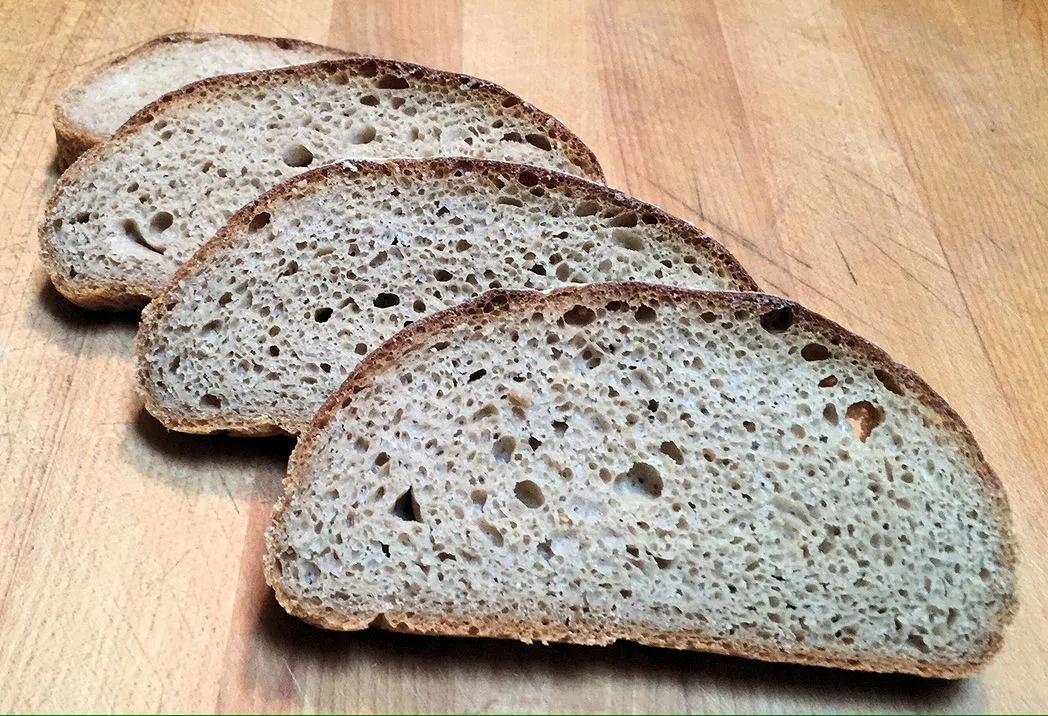
First time trying 100% whole wheat bread and am not sure what needs to be done regarding crumb. Also, am not sure if it should have been baked more. Question? I baked mine in a pan for the first 20 minutes. Steam for 15 minutes, removed from pan and placed on Pizza Stone. Finished baking for a total of 35 minutes, plus left in oven for another 10 with door cracked open. Baked at 450F. Hydration was probably a bit over 100%.
Input as to how to make it lighter. Was afraid to just put on the stone as I was afraid it would flatten out too much. The pans were about 6 inches wide and about 12 inches long.
Any suggestions would be appreciated. First hubby said "too dense" when he looked at it, so I was going to dump it, but now he said save it. He tasted it and thought it was good. He is diabetic so wanted to try all whole wheat.
The crumb looks quite open for a 100% whole wheat loaf, actually. Whole wheat bread tends to be more dense than its all-white counterpart but there are some things you can do to address that. You might want to read dmsnyder's account of working with 100% whole wheat, here, or txfarmer's account, here. Both contain some valuable insights.
It must have been a challenge handling a dough that's more than 100% hydration, even if it is whole wheat.
Something else to consider, considering your husband's diabetes, is using sourdough instead of commercial yeast. Anecdotal evidence suggests that there may be less of a spike in blood sugars after eating a sourdough bread than a comparable bread made with commercial yeast.
Paul
I'll check out the links that you are providing. As for Sourdough. I used to keep a culture but my husband won't even try sourdough, he says he doesn't like it so I got rid of it. I started with a purchased one from King Arthur Flour but was sick of feeding it all the time, if I couldn't use it. So that is out. I still make white bread, and rye with white flour in it, but thought I would try all whole wheat.
I'll read the posts you provided but they hydration was as least 100%+. Just wondered how I would be able to bake the dough without using a pan and it flattening out. Appreciate your input.
gotten rid of the hubby instead. :p
Actually, my point is to suggest that you can do what I do when I bake certain breads my wife isn't fond of, which is to freeze half.
Some people like a really sour San Francisco sourdough flavour, but I prefer a milder, sweet flavour to my natural levain breads. It is possible to adjust the flavour of your levains from sour to sweet.
Ken Forkish, in his book Flour, Water, Salt, Yeast does a great description of how to manipulate the variables in a 'sourdough' bread. Like Ken I call it levain. FWSY is a great book. The short story, is the cooler and lower hydration of your levain the more sour acetic acid flavour you get. If you opt for a high hydration starter, say 80-100% and warmer ferment temperatures, say 70F instead of fridge and you will realize more acetic acid, or sweeter levain flavours.
For sweet doughs I keep a sweet strong bread flour levain. For feeding I just keep just 10 grams of levain and using 50g of strong bread flour and 50 g 90F water. This provides just enough levain at 100 grams to raise a 500 gram loaf, plus enough left over to feed again. Natural levain breads simply taste better when you get them down.
Give it a try and happy baking! Ski
Forgot to add, hubby likes his bread to be the texture of Italian or Ciabatta bread, so I don't add any extra ingredients. I have make sandwich bread with a water roux. He likes that but he is more into crusty Italian bread type, that is why I only used water, flour, yeast and salt. Was contemplating adding honey but didn't.
Love him too much, plus he does all the cooking. I talked to him again about sourdough, and he thinks maybe he would try it now, since it is better for his health. But I don't know if I want to buy another culture to see if he likes it. I do have some dried sourdough starter that's been in the freezer a long time. Wonder if that would still work instead of my buying more. I tried making it using the pineapple juice method but it never did work out for me.
Input is appreciated. We do freeze bread since it's only two in the family. My children live in different States.
As already noted, the hydration of your starter makes a difference. So does how much you use; it's not necessarily intuitive, but more starter (as a % of the flour weight) produces less sourness. And a starter made with AP or white bread flour will be less sour than one with whole wheat and/or rye.
Add in that method can matter too, and it's possible to make an SD loaf that quite a few people won't recognize as being SD unless you tell them.
I didn't use a starter. I assume you mean sourdough starter. I used a Poolish. The bread had yeast in it. I finally convinced my husband that SD is good for you so am going to start working with SD and see how he likes it. I did tell him, that just because SD is better than the other, why I don't know, that he can't go overboard and eat a lot of bread. Will see how this works out.